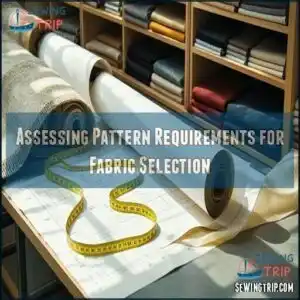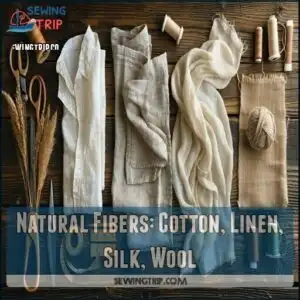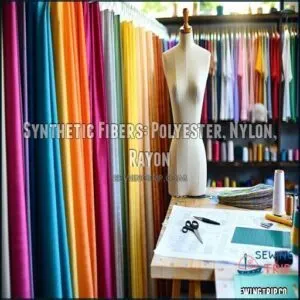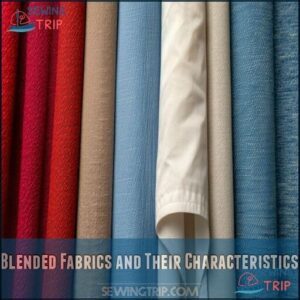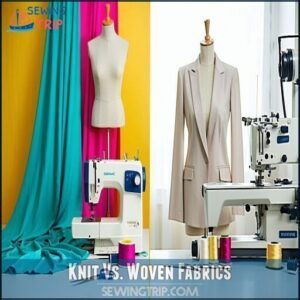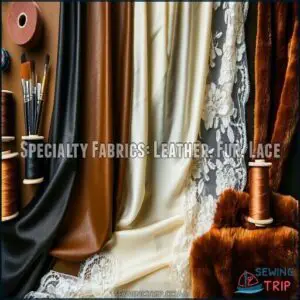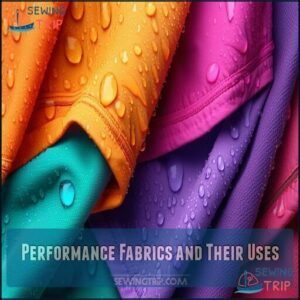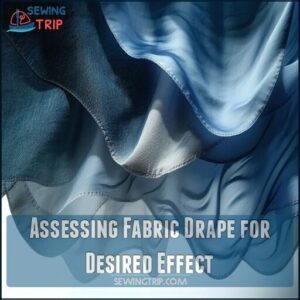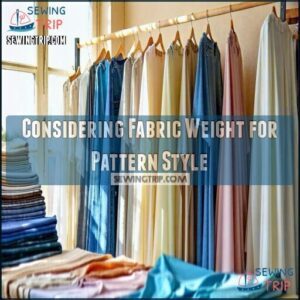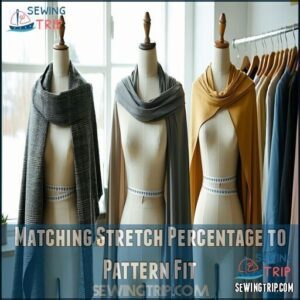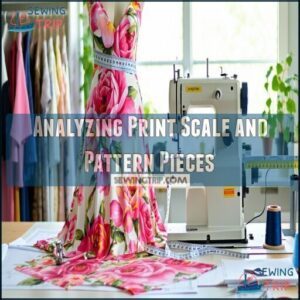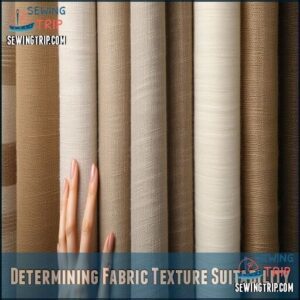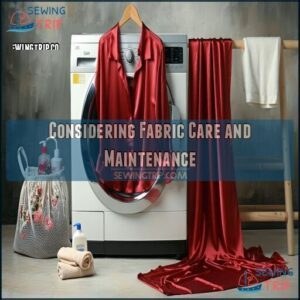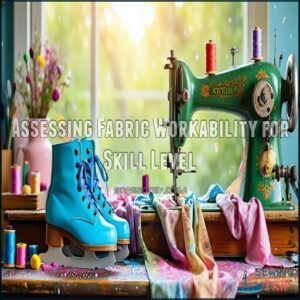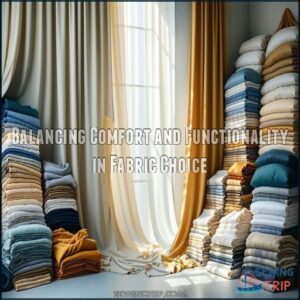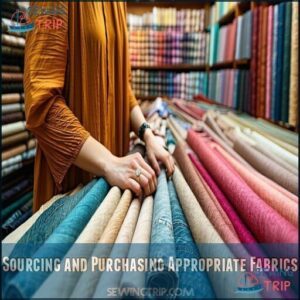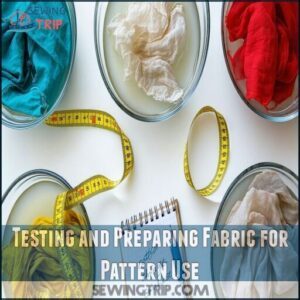This site is supported by our readers. We may earn a commission, at no cost to you, if you purchase through links.
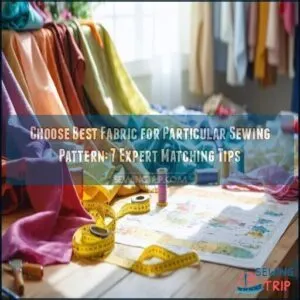
For instance, a flowy dress might need lightweight rayon, while structured pants call for sturdy twill. Test swatches to see how they feel and behave.
Pre-wash to avoid post-sewing shrinkage surprises (trust me, it’s heartbreaking). Also, match stretch fabrics to fitted patterns for comfort and movement.
Don’t forget care instructions—silk might look stunning but hates the washing machine. The right fabric brings your vision to life, so choose wisely and sew confidently!
Table Of Contents
- Assessing Pattern Requirements for Fabric Selection
- Exploring Fabric Types and Their Properties
- Matching Fabric Characteristics to Pattern Design
- Considering Fabric Care and Maintenance
- Evaluating Fabric Aesthetics and Visual Appeal
- Assessing Fabric Workability for Skill Level
- Balancing Comfort and Functionality in Fabric Choice
- Sourcing and Purchasing Appropriate Fabrics
- Testing and Preparing Fabric for Pattern Use
- Frequently Asked Questions (FAQs)
- Conclusion
Assessing Pattern Requirements for Fabric Selection
You’ll save yourself a mountain of frustration by carefully examining your pattern envelope before rushing to buy fabric, as it contains critical information about recommended materials, weight, and stretch requirements.
Understanding these specific fabric requirements is like having a roadmap to sewing success, helping you avoid that dreaded moment when you realize your beautiful silk won’t work for a structured jacket midway through cutting.
This step is crucial because it helps you avoid unnecessary mistakes and ensures that your project turns out as expected, with the right fabric choices making all the difference.
Analyzing Pattern Envelope Information
Your pattern envelope isn’t just packaging—it’s your secret decoder ring for fabric selection success! Think of it as your sewing GPS, guiding you to the perfect materials for your project.
- Fabric suggestions aren’t random—they’re expert recommendations tested with your design
- Sizing charts help calculate exactly how much fabric you’ll need
- Garment sketches reveal design elements that affect drape and structure
- Notions list saves you from that midnight dash to the craft store
- Skill level indicators tell you if you’re in over your head
Learning to read these pattern requirements is like discovering a cheat code for gorgeous garments. Trust your pattern envelope—it knows what it’s talking about!
Identifying Recommended Fabric Types
Now that you’ve examined your pattern envelope details, let’s focus on those fabric suggestions – they’re not just casual recommendations but expert roadmaps to success.
When reviewing the envelope guidance, pay close attention to fabric types, which reveal exactly what the designer had in mind for your project.
| Fabric Type | Best For | Pattern Compatibility |
|---|---|---|
| Cotton | Structured pieces | Crisp collars, detailed pockets |
| Silk | Flowing designs | Drapey blouses, elegant dresses |
| Denim | Utilitarian items | Hard-wearing jackets, sturdy bags |
These expert suggestions aren’t random – they’re carefully selected based on how fabrics interact with pattern construction techniques and affect your garment’s final look and feel, making them carefully selected and expert roadmaps to ensure a successful project.
Understanding Fabric Weight Suggestions
After identifying your fabric type, you’ll need to tackle weight—a game-changer for how your finished garment hangs and feels.
Your pattern isn’t just suggesting fabric weights; it’s giving you a blueprint for success! Fabric weight (measured in GSM or ounces per square yard) determines whether your creation will stand proud or flow gracefully.
- Lightweight fabrics (under 150 GSM) dance and float—perfect for breezy summer dresses
- Medium-weight fabrics (150-300 GSM) offer that "just right" balance for everyday wear
- Heavyweight fabrics (300+ GSM) provide structure for custom-made jackets and coats
- Seasonal weights vary—lighter for summer, heavier for winter garments
Remember: the right weight creates the right drape!
Evaluating Stretch Requirements
While fabric weight affects how your garment hangs, stretch requirements determine how well it fits.
Your pattern envelope reveals exact stretch percentages needed—usually 25-50% for comfortable movement.
When testing fabrics, pinch and pull a section about 3 inches wide.
Quality stretch fabrics should bounce back immediately, showing good recovery.
Most patterns specify whether you need 2-way stretch (horizontal only) or 4-way stretch (both directions).
This simple test prevents disappointment after cutting your fabric.
Considering Drape and Structure Needs
When selecting fabric for your pattern, understanding drape and structure needs is vital to achieving the designer’s intended look.
Drape refers to how fabric hangs and moves on the body, directly impacting your garment’s silhouette style.
Fabric structure and drape affect your project in these ways:
- A flowing silk creates romantic, soft lines perfect for evening wear
- Structured cotton canvas stands firm for custom-made jackets that hold their shape
- Medium-weight linen offers that perfect balance between flow and stability
- Seasonal weight considerations guarantee comfort (no wool sundresses!)
- Texture impact can completely transform a simple design into something special
Remember: your fabric’s personality—whether it flows like water or stands at attention—determines if your finished piece matches your pattern’s vision.
Examining Notions and Interfacing Recommendations
Beyond your fabric choice, don’t skip the fine print about notions and interfacing in your pattern. They’re like the supporting actors that make the star shine.
Always test interfacing compatibility on a scrap first—I once ruined a silk blouse with bubbling fusible that wouldn’t stick. You can find various types of fusible interfacing options online.
| Interfacing Type | Best Use | Fabric Compatibility |
|---|---|---|
| Fusible Woven | Collars, Cuffs | Medium-weight fabrics |
| Fusible Knit | Stretchy garments | Knits, jerseys |
| Sew-in | Delicate fabrics | Silks, sheers |
| Non-woven | General purpose | Most fabrics |
| Horsehair | Structured hems | Formal wear |
Pattern recommendations aren’t random; they’re like a recipe’s ingredient list, ensuring your stabilizer selection supports your fabric perfectly.
Exploring Fabric Types and Their Properties
You’ll need to understand fabric personalities just as much as pattern requirements if you want your sewing projects to shine rather than flop.
From the crisp structure of cotton to the fluid drape of silk, each fabric type brings unique properties that can make your garment either a stunning success or a disappointing disaster.
Natural Fibers: Cotton, Linen, Silk, Wool
Every natural fiber tells a different story when paired with your sewing pattern. Understanding their unique personalities helps you create garments that both look and feel amazing.
Cotton serves as your reliable best friend in sewing—absorbent, durable, and available in countless weave types from lightweight voile to sturdy denim. It’s perfect for that summer dress pattern you’ve been eyeing.
Linen offers exceptional breathability that’ll keep you cool, though you’ll need to embrace its charming wrinkles as part of its character.
Three natural fibers that will transform your sewing projects:
- Silk with its luxurious drape that turns a simple pattern into something spectacular
- Wool with its natural stretch that forgives minor fitting issues
- Organic cotton for ethical sourcing without sacrificing quality
Remember that natural fiber blends often give you the best of both worlds—merino wool with silk creates garment applications that combine warmth with elegant drape, making it a great choice for creating amazing garments that are both functional and visually appealing, with a luxurious feel.
Synthetic Fibers: Polyester, Nylon, Rayon
Countless synthetic fibers offer game-changing benefits for your sewing projects, often solving problems that natural fibers can’t.
| Fiber | Properties | Best For | Care | Pattern Matching |
|---|---|---|---|---|
| Polyester | Durable, wrinkle-resistant | Everyday wear, kids’ clothing | Machine wash, low heat | Structured patterns |
| Nylon | Strong, waterproof | Activewear, gear bags | Gentle cycle, air dry | Technical patterns |
| Rayon | Silky drape, breathable | Flowy dresses, blouses | Hand wash, hang dry | Drapey designs |
| Acetate | Glossy, lightweight | Linings, special occasion | Dry clean only | Formal patterns |
| Acrylic | Wool-like, warm | Sweaters, winter wear | Machine wash, reshape | Cozy patterns |
When matching synthetic fibers to patterns, consider how polyester durability might benefit children’s clothes, while rayon drape creates stunning movement in a flowy dress. Microfiber properties offer the perfect balance for everyday garments, providing a wool-like feel and breathable comfort, making them ideal for everyday wear and special occasion garments.
Blended Fabrics and Their Characteristics
While synthetic fibers offer durability, blended fabrics give you the best of multiple worlds.
Fabric combinations merge natural and synthetic properties for superior performance in your sewing projects.
Consider these key advantages:
- Comfort-durability balance: Cotton-poly blends provide breathability with added strength
- Shape retention: Spandex-enhanced fabrics maintain form after countless wears
- Care flexibility: Many blends resist wrinkles and require less ironing
Fiber content percentages matter—higher natural content feels softer against skin, while synthetic additions improve longevity.
Your pattern will thank you!
Knit Vs. Woven Fabrics
The fundamental difference between knit and woven fabrics can make or break your sewing project.
Understanding these two fabric types will help you nail your pattern selection every time.
Here’s what sets them apart:
- Stretch capacity: Knit fabrics stretch and recover like yoga pants, while woven fabrics maintain stability with minimal give
- Fabric drape comparison: Wovens create structured silhouettes; knits flow and hug body contours
- Cutting considerations: Wovens demand precise grain alignment; knits require attention to stretch direction
- Seam finishes: Woven edges fray and need finishing; knit edges generally stay intact
For fitted patterns requiring movement, choose knits with good stretch recovery.
For structured pieces needing crisp lines, wovens are your best friend.
Jersey knit is popular because it’s soft and stretchy, making it ideal for t-shirts.
You’ll never match the wrong fabric to your pattern again!
Specialty Fabrics: Leather, Fur, Lace
Behind the scenes of extraordinary sewing projects often lie specialty fabrics that require special handling.
Leather durability is legendary, but you’ll need special needles and minimal pinning to avoid permanent holes. Available in both genuine and faux varieties, leather’s waterproof quality makes it ideal for bags and jackets.
Lace techniques vary by type—from delicate Chantilly to structured guipure—with each requiring different fabric selection approaches. Try exciting fabric combinations like Metallic Coated Chantilly Lace for unique texture.
When considering fur, many sewists face alteration challenges and ethical questions. Faux alternatives mimic the luxurious feel without moral dilemmas.
Before purchasing these specialty fabrics, check your sewing pattern fabric requirements—specialty fabrics rarely forgive fabric fraying mistakes!
Performance Fabrics and Their Uses
Performance fabrics transform your sewing projects from simple to sensational.
Engineered to handle harsh conditions, these technical textiles bring hardcore functionality when regular fabrics won’t cut it.
- Sportswear fabrics feature moisture-wicking synthetics that pull sweat away from skin—imagine running in a shirt that keeps you dry even during your sweatiest workout
- Outdoor gear materials combine waterproofing with breathability—perfect for hiking jackets that repel rain but don’t turn into personal saunas
- Medical textiles offer antimicrobial properties—essential for face masks or items requiring extra protection
Match your fabric’s performance properties to your activity level.
UV protection fabrics shield you during sunny adventures, while military applications need durability for extreme conditions.
Industrial uses demand fabrics that withstand repeated washing and wear.
Matching Fabric Characteristics to Pattern Design
Choosing the right fabric for your pattern isn’t just about picking something pretty—it’s about making sure it works with the design.
By considering things like drape, weight, and stretch, you’ll avoid sewing frustrations and end up with a garment that fits and feels just right, ensuring a successful sewing experience with the right fabric.
Evaluating Garment Silhouette and Structure
Choosing the right fabric for a garment’s silhouette is like finding the perfect dance partner—it’s all about compatibility.
When tackling Silhouette Analysis, think about how fabric weight and drape will shape your design.
Structured garments demand fabrics with strong Structural Integrity, while flowing designs thrive on soft, pliable materials.
Here’s a quick guide:
| Silhouette | Best Fabrics | Why It Works |
|---|---|---|
| Fitted/Tailored | Cotton twill, denim | Sharp lines, defined edges |
| A-line/Flared | Medium-weight linen, cotton | Balanced movement and structure |
| Draped/Flowing | Silk, rayon, jersey | Graceful folds and fluidity |
| Structured/Architectural | Canvas, heavyweight cotton | Holds shape for dramatic designs |
Fabric Compatibility shapes how your garment silhouette behaves, so picture its final drape and fit before choosing!
Assessing Fabric Drape for Desired Effect
Fabric drape is the unsung hero of a garment’s silhouette. It’s about how fabric flows, or stands firm, when worn—and it can make or break your design.
Imagine this scenario: structured fabrics like denim create bold, architectural looks, while silk charmeuse flows like water over curves.
Test drape by holding the fabric up to eye level and watching how it behaves. Does it flow freely, or stand still like a board? Match the drape to your pattern’s vibe.
Here’s your quick fabric drape guide:
- Rigid fabrics (organza, denim): structured, dramatic designs.
- Crisp fabrics (poplin, taffeta): sharp yet flexible looks.
- Soft fabrics (rayon, silk): free-flowing, elegant garment shapes.
Considering Fabric Weight for Pattern Style
Fabric weight isn’t just a number—it’s the backbone of your garment’s personality.
Lightweight fabrics (under 100 GSM) are perfect for breezy summer dresses, offering effortless flow and movement. Medium-weight fabrics strike a balance, ideal for blouses or skirts needing a bit of structure.
Heavyweight fabrics (300+ GSM) shine in coats or formal outfits, giving that polished, formal vibe.
Always factor in seasonal weight—lighter for heat, heavier for chilly days.
Drape consideration matters too; mismatched fabric weight can wreck your garment silhouette, so nail your fabric selection to suit your sewing pattern!
Matching Stretch Percentage to Pattern Fit
Getting the stretch percentage right is like finding the perfect dance partner—it needs to move with you, not against you.
Here’s how to match fabric stretch percentage to your sewing pattern:
- Low-stretch fabrics: Great for structured designs; no surprises here.
- Moderate stretch fabrics: Offer comfort and shape; perfect for casual wear.
- High-stretch fabrics: Ideal for activewear, but demand precision for negative ease.
Always test fabric recovery to avoid sagging disasters!
Analyzing Print Scale and Pattern Pieces
Prints can make or break your sewing pattern, so let’s talk strategy. Start with print size—large prints work best on simple, broad areas like bodices or skirts, while small designs shine on intricate spots like collars or cuffs.
For visual harmony, consider the complexity of your pattern. Busy prints can overwhelm detailed designs, so balance is key.
Pay attention to motif placement. Directional prints, like stripes or florals, need careful alignment—nobody wants sideways stripes on a dress!
For bordered fabrics, highlight unique edges on hemlines or sleeves. Random prints? They’re a breeze, with no matching stress.
Achieving the best results often requires understanding fabric grain for proper alignment.
Determining Fabric Texture Suitability
Texture is the handshake between your pattern and fabric—it must feel right.
When matching fabric texture to your pattern, consider how the surface feel affects your garment’s visual impact and functionality.
- Rough textures can overwhelm intricate pattern details
- Smooth fabrics highlight complex seam work and design elements
- Nubby textures add interest to simple patterns but fight with busy designs
- Fabric hand feel should match intended use—silk for elegant drape, canvas for structure
- Pattern complexity often demands simpler texture for balance
Trust your fingers—they’ll tell you if it’s right, and remember that texture is about finding the right balance.
Considering Fabric Care and Maintenance
You’ll save yourself countless headaches by choosing fabrics that match your lifestyle and cleaning habits, not just your pattern requirements.
That gorgeous silk might look stunning as a blouse, but if you’re not ready for hand-washing and careful ironing, you might find your beautiful creation gathering dust in the closet rather than becoming your favorite garment.
Washing and Drying Requirements
Now that you’ve matched your fabric to the pattern, let’s talk care instructions! Your perfect garment deserves proper maintenance to last.
When you bring fabric home, don’t skip the pre-wash step. This controls shrinkage allowance and reveals any color bleeding issues before cutting your precious pattern pieces.
Check washing instructions on the bolt or manufacturer’s website. Natural fibers often shrink more than synthetics. Cottons typically need warm water, while delicates require cold and gentle cycles. For example, linen prefers air drying to maintain its quality.
Your drying method matters too—some fabrics warp with heat while others need tumbling to maintain softness.
- One mishandled wash can transform your crafted masterpiece into an unwearable doll outfit!
Ironing and Pressing Needs
Before you tackle your sewing project, understanding the ironing and pressing needs of your fabric can make or break your finished garment.
Your fabric’s properties directly determine which pressing tools and techniques you’ll need. Cotton welcomes high ironing temperatures with plenty of steam, making it a dream to press. In contrast, silk demands gentle handling—low heat, a press cloth barrier, and absolutely no steam to preserve its luxurious sheen.
Always follow washing instructions on your fabric for consistent care. Remember, matching your pressing technique to your fabric’s sensitivity isn’t just good practice—it’s how you’ll prevent damage and achieve those crisp, professional-looking seams that make handmade garments shine.
Fabric Durability and Longevity
When you’ve mastered pressing techniques, don’t forget what keeps your creation looking good long-term—durability.
Your fabric’s lifespan matters just as much as its beauty.
Look for these quality indicators:
- Fiber Strength: Tightly twisted yarns resist breaking and fraying
- Weave Density: Close, compact weaves withstand daily wear
- Abrasion Resistance: Fabrics that don’t pill or thin out where friction occurs
Test durability by rubbing samples together—fabrics that maintain their color and texture will serve you best.
Special Care Instructions for Delicate Fabrics
Beyond durability, handling delicate fabrics requires special attention to maintain their beauty.
When working with silk, lace, or chiffon, you’ll need gentler care routines.
Always check the fiber content before cleaning—it’s your roadmap to proper maintenance.
Hand wash these treasures in lukewarm water with mild detergent, or befriend your local dry cleaner.
For drying techniques, skip the machine and lay flat in shade.
When pressing, use low heat with a pressing cloth as your protective barrier.
Smart storage methods matter too—avoid hanging delicate pieces, and instead fold with acid-free tissue.
For unexpected stains, blot (don’t rub!) immediately with appropriate solutions.
Fabric Shrinkage and Pre-washing Considerations
Fabrics have secrets they reveal only after washing!
Pre-washing your material before cutting prevents those dreaded "too small" moments.
Cotton can shrink up to 10%, while synthetics barely budge.
Run wash tests to check for color bleeding and fabric relaxation.
Always use the same washing machine settings you’ll use later for cleaning.
This simple fabric preparation step guarantees your finished garment fits perfectly after every wash.
Stain Resistance and Cleaning Methods
While pre-washing prevents shrinkage, stain resistance keeps your creations looking fresh longer.
When selecting fabrics, consider how they’ll handle everyday spills and mishaps. Different fibers respond uniquely to cleaning methods – cotton welcomes hot water while silk runs from it!
- Apply fabric protectants before first wear, especially on natural fibers with high absorption rates
- Check care labels before treating stains; what works for polyester might ruin wool
Always test cleaning products on scraps first, and remember to handle your creations with care to ensure they last, using methods that are suitable for the specific fiber type.
Evaluating Fabric Aesthetics and Visual Appeal
You’ll transform your sewing projects from merely functional to truly eye-catching when you match fabric aesthetics with your pattern’s design intention.
Beyond the technical requirements, choosing fabrics with colors, prints, and textures that complement your personal style and the garment’s purpose will create pieces you’ll actually want to wear, and this is where you can add a truly eye-catching touch by making informed decisions about aesthetics.
Color Selection and Complementing Skin Tone
While caring for your fabric guarantees longevity, choosing colors that complement your skin tone creates garments you’ll actually wear.
Understand your undertones—warm skin glows in earthy tones, while cool complexions shine in jewel shades.
| Skin Undertone | Best Colors | Avoid |
|---|---|---|
| Warm | Peach, gold, amber | Pure white, stark blue |
| Neutral | Most colors work | None specifically |
| Cool | Blues, purples, emerald | Orange, bright yellow |
Select colors that match your personal style and integrate with your existing wardrobe to ensure longevity.
Print Patterns and Their Impact on Design
Print patterns can make or break your sewing project, influencing how others see your finished piece.
Selecting the right printed fabric creates visual harmony with your pattern design.
Here’s how different prints impact your project:
- Print scale matters – tiny florals suit detailed garments while bold, large motifs work better on simple designs
- Pattern matching at seams prevents jarring visual breaks in your garment
- Directional prints require extra fabric and careful cutting to maintain consistency
- Bold prints can cleverly hide seams and minor fitting imperfections
When choosing fabric patterns, consider how they’ll interact with darts, pleats, and other design elements for the best visual texture.
Fabric Texture and Its Visual Effect
Running your fingers across a fabric reveals its texture perception—the personality behind your garment.
Smooth surfaces with high surface reflection (like satin) create elegance, while matte textures with visual weight (like bouclé) add cozy dimension.
When choosing fabric for patterns, consider how texture combinations will enhance the design’s overall impact.
A structured tweed gives crafted pieces authority, while flowing chiffon softens silhouettes.
The fabric visual texture can transform simple patterns into statement pieces—pair ribbed knits with minimalist designs or use textured linen for added fabric depth that catches light beautifully, creating a sense of fabric depth.
Considering Personal Style Preferences
Your personal style is the heart of every successful sewing project.
When selecting fabrics for patterns, follow these three essential steps:
- Wardrobe Coordination: Choose fabrics that blend with your existing clothes for maximum wearability
- Color Palettes: Select hues that complement your skin tone and reflect your fabric personality
- Style Evolution: Match fabric structure to your preferred silhouettes—structured wovens for polished looks, flowy rayons for casual comfort
Seasonal Appropriateness of Fabric Choices
Seasonal fabric selection can make or break your sewing project.
Choose lightweight cotton or linen for summer fabrics that breathe when temperatures soar. Winter warmth demands wool or fleece with insulating properties.
Spring layering works best with medium-weight fabrics that shift easily, while autumn textures like flannel or corduroy offer cozy comfort.
Always consider climate considerations and your activity level when matching patterns to seasonal fabrics.
Trend Analysis for Current Fabric Styles
Beyond seasonal choices, fabric trends can elevate your sewing pattern.
Today’s sustainable fabrics and lustrous textures aren’t just stylish—they’re smart picks for your next project.
Try these trending options for 2025:
- Natural textures: Wrinkled linens and textured knits for a handmade feel
- Eco-friendly fibers: Organic cotton and Tencel for earth-conscious sewists
- Metallic accents: Shiny fabrics adding 49% more visual interest
- Green and blue palettes: Nature-inspired colors for timeless appeal
Assessing Fabric Workability for Skill Level
You’ll save yourself hours of frustration by matching your fabric choice to your current sewing skills, just like you wouldn’t attempt a triple axel the first time you put on ice skates.
Cotton and linen are your trusty training wheels when starting out, while slippery silks and temperamental knits can wait until you’ve mastered the basics of controlling fabric under your presser foot, which is a fundamental skill to achieve sewing skills.
Identifying Beginner-friendly Fabrics
While visual appeal matters, your skill level should guide fabric selection too.
New to sewing? You’ll want Easy-Care Fabrics with Simple Weaves and Minimal Stretch.
When buying fabric for beginners, stick with these forgiving options:
- Muslin cotton: Affordable and doesn’t fight your scissors
- Quilting cotton: Holds still when you pin it
- Flannel: Grips itself, won’t slip away
- Cotton poplin: Behaves predictably under your presser foot
- Stable knits: Won’t make you cry when hemming
Recognizing Challenging Fabrics for Advanced Sewers
As you’ve mastered beginner fabrics, it’s time to tackle the sewing world’s troublemakers.
Advanced sewers face unique challenges with fabrics that demand specific techniques and plenty of patience.
The following fabrics are known to be particularly challenging:
| Challenging Fabric | Key Characteristics | Handling Tips | Recommended Tools | Skill Level |
|---|---|---|---|---|
| Silk | Slippery, frays easily | Cut on single layer, use weights | Sharp scissors, fine pins | Advanced |
| Velvet | Directional pile, marks easily | Avoid pressing directly, use needle board | Walking foot, velvet pins | Advanced |
| Leather | No seam allowance changes, holes permanent | Use clips not pins, special needles | Leather needle, Teflon foot | Expert |
| Sequined fabrics | Damages needles, uneven surface | Remove sequins from seam allowances | Heavy-duty needles, patience | Expert |
| Chiffon | Ultra-slippery, transparent | Sandwich between tissue paper, stabilize | New sharp needles, microtext pins | Advanced |
These challenging fabrics aren’t for the faint-hearted, but they’ll take your sewing skills to new heights with the right techniques and tools.
Working with these materials requires a combination of skill and experience, making them ideal for advanced and expert sewers.
Evaluating Fabric Behavior During Cutting and Sewing
You’ll quickly discover that fabrics have their own personality when it’s time for cutting and sewing.
Understanding these quirks helps you avoid frustration and achieve professional results.
When evaluating fabric behavior during your project, watch for:
- Shifting tendencies – Slippery fabrics like satin or chiffon can slide around under your scissors, demanding pattern weights or fine pins for cutting precision
- Needle compatibility – Dense fabrics need strong needles while delicates require fine ones to prevent damage
- Tension requirements – Each fabric demands specific tension adjustments; too tight causes puckering, too loose creates loops
Test scraps before diving in—your future self will thank you!
Considering Seam Finishes for Different Fabrics
After mastering cutting techniques, you’ll need to match seam finishes to your fabric’s unique personality.
Your fabric’s characteristics directly impact which seam finish will work best. Lightweight silks beg for French seams to hide raw edges, while stable cottons do fine with simple zigzag stitching.
Knits? They’ll thank you for a stretchy overlock stitch that moves with them. Consider your fabric’s fraying tendencies and weave density when choosing finishes.
Hong Kong seams add class to unlined jackets but create bulk in lightweight materials. For visible seams, flat-felled finishes offer both durability and style—perfect for denim and sturdy twills.
Analyzing Fabric Fraying Tendencies
When selecting fabrics, understanding fraying tendencies will save you countless headaches later.
Loose weaves like chiffon practically disintegrate without proper edge treatments, while tightly woven fabrics like denim stand their ground.
Simply tug a few threads near the edge to test – if they unravel easily, plan for reinforced seam finishes.
- Control fabric fraying with serged edges, French seams, or bias binding – each fabric density requires specific techniques
- Match seam finishes to fabric weave density for durability that lasts through countless washes
Determining Ease of Pattern Alterations
Beyond fabric fraying issues, you’ll need to keep in mind how your fabric choice affects pattern alterations. Different fabrics respond uniquely when you modify patterns.
Fabric forgiveness plays a huge role in alteration success. Stable cottons let you adjust with ease, while slippery silks might make you want to pull your hair out!
| Fabric Type | Pattern Ease | Grainline Impact |
|---|---|---|
| Cotton/Linen | High forgiveness | Maintains stability |
| Silk/Rayon | Low forgiveness | Shifts easily |
| Knits | Medium forgiveness | Stretches unpredictably |
| Wool | High forgiveness | Reshapes with steam |
| Denim | Medium forgiveness | Requires extra seam allowance |
Remember: the right fabric makes alterations a breeze, the wrong one creates a headache!
Balancing Comfort and Functionality in Fabric Choice
You’ll need to strike the perfect balance between comfort and function when selecting fabric for your pattern, just like choosing running shoes that look great but won’t leave you with blisters.
Your fabric choice must work hard to serve its intended purpose—whether it’s breathing in summer heat or keeping you cozy in winter—while still feeling good against your skin during wear.
Assessing Breathability for Different Climates
Now that you’ve mastered fabric handling skills, let’s talk climate comfort! Your fabric’s breathability directly affects how comfortable your finished garment feels in different weather conditions.
Weave density impacts how easily air flows through material and regulates body temperature. Natural fibers offer superior fiber breathability—cotton breathes in summer heat while wool provides thermal regulation that’s warm yet breathable.
Fabric climate considerations matter whether you’re sewing sundresses or winter coats!
- Hot climates demand loose-weave linens and lightweight cottons
- Humid environments need moisture management from quick-drying fabrics
- Cold weather calls for breathable wool that wicks away sweat
- Variable conditions require smart fabric layering for breathability comfort
Evaluating Fabric Stretch for Movement
While breathable fabrics keep you cool, your garment’s stretch factor determines how freely you’ll move in it.
When matching patterns to fabrics, test stretch percentage by pulling the fabric diagonally to feel its bias stretch.
Knit fabrics typically offer superior movement comfort with either 2-way or impressive 4-way stretch.
For activewear, focus on recovery rate—how quickly fabric bounces back after stretching.
Considering Fabric Weight for Intended Use
Fabric weight fundamentally shapes how your finished garment functions. When matching fabric to your sewing pattern, consider what you’ll use the garment for – a sundress needs lightness, while outerwear demands structure. Your pattern envelope offers critical fabric weight guidance for good reason!
- Lightweight fabrics (chiffon, voile) create flowing silhouettes perfect for summer wear
- Medium-weight fabrics (quilting cotton, linen) offer versatile year-round functionality
- Heavyweight fabrics (denim, wool) provide structure and warmth for winter projects
- Specialty weights match activity needs – sturdy canvas for bags, lighter cotton for shirts
Fabric drape consideration impacts how the garment moves with your body
Analyzing Moisture-wicking Properties
While fabric weight matters for comfort, how it handles sweat is equally important.
Performance fabrics with moisture-wicking properties pull perspiration away from skin through specialized fabric construction.
Synthetic polyester and natural merino wool excel at this task.
Look for tight weave density and wicking finishes when selecting patterns for activewear.
You can test breathability by placing a drop of water on the fabric—quick absorption signals good fiber performance for high activity levels.
Determining Insulation Needs for Outerwear
While moisture-wicking keeps you dry, your outerwear’s insulation decides how warm you’ll stay in chilly conditions.
When selecting fabric for your jacket or coat pattern, match insulation types to your specific needs.
Consider these factors when choosing insulated fabrics:
- Down fill power (550-900) determines warmth-to-weight ratio
- Synthetic insulation performs better in wet conditions
- Wool provides warmth even when damp
- Fleece offers lightweight thermal regulation
- Quilted layers create air pockets for improved heat retention
Your activity level and local climate should guide your fabric choice. Remember, the perfect insulation balances warmth without restricting movement or creating uncomfortable bulk.
Evaluating Fabric Opacity for Lining Requirements
When selecting fabric for your pattern, understanding opacity levels is essential for determining lining needs.
Testing fabric sheerness by holding it against light reveals whether you’ll need additional layers for coverage.
| Fabric Type | Opacity Level | Lining Requirement | Color Impact | Best Uses |
|---|---|---|---|---|
| Silk Chiffon | Very Low | Always needed | Darkens with layering | Evening wear |
| Cotton Lawn | Medium | Sometimes needed | Minimal change | Summer dresses |
| Wool Crepe | High | Rarely needed | Maintains true color | Structured pieces |
| Polyester | Medium-High | Optional for comfort | Minimal change | Everyday wear |
| Linen | Medium | Depends on weave | Can show shadows | Casual garments |
Remember, even opaque fabrics might benefit from lining for structure or comfort, and understanding the lining requirement is crucial for the best results.
Sourcing and Purchasing Appropriate Fabrics
You’ll save yourself countless headaches and "what was I thinking" moments by knowing exactly where to find quality fabrics that perfectly match your pattern requirements.
Finding the right fabric source is like finding a good hairstylist – once you discover shops with knowledgeable staff and quality materials that fit your budget, you’ll never want to shop anywhere else, because they offer a unique combination of knowledgeable staff.
Identifying Reputable Fabric Suppliers
The hunt for trusted fabric suppliers can feel like finding a needle in a haystack.
Look for these key qualities:
- Strong reputation backed by honest online reviews
- Quality assessment options through sample swatches
- Clear pricing without hidden costs or surprises
- Ethical sourcing practices and sustainability commitments
- Generous return policies for peace of mind
Building solid supplier relationships saves headaches later.
Many sewists find their perfect fabric source through recommendations from sewing communities or by testing smaller orders first.
You may also find various fabric options online.
Comparing Online Vs. In-store Fabric Shopping
The fabric hunt presents a classic dilemma: online versus in-store shopping.
In-store offers the irreplaceable Tactile Experience of feeling fabrics and Expert Advice from seasoned sewists.
Meanwhile, online fabric retailers provide vast selection, competitive pricing, and convenient browsing.
Consider Shipping Costs and Return Policies carefully before clicking "buy."
Local fabric stores near me offer immediate gratification, while online shops excel when you’re seeking specialty materials that require thorough Fabric Inspection before purchasing.
Understanding Fabric Width and Yardage Calculations
Every inch matters when calculating yardage for your project!
Proper yardage estimation prevents fabric waste and frustration.
The fabric width impact can make or break your layout efficiency. A key aspect is that a fabric yard equals three feet.
Master coordinated yardage with these steps:
- Study pattern layouts carefully to understand placement
- Measure fabric width twice before cutting once
- Add 1/4 yard extra for pattern matching
- Include a "whoops buffer" for inevitable snafus
Evaluating Fabric Quality and Pricing
Smart sewists examine fiber content and weave density first when judging fabric quality.
You’ll find ethical sourcing often explains higher prices, but fabric pricing transparency varies widely among suppliers.
Your fabric quality assessment should include simple testing methods like burn tests to reveal true value.
Remember that better fabrics with higher fabric pricing value save money long-term.
Trust fabric supplier reputation over bargain prices when investing in your sewing projects.
Requesting and Analyzing Fabric Swatches
While evaluating fabric quality, don’t forget your best decision-making tool: fabric swatches.
Think of swatches as your "try before you buy" insurance policy. When you hold that little square in your hands, you’ll experience the real tactile experience that online photos can’t provide.
Test your fabric samples thoroughly:
- Rub it against your skin to check comfort and potential irritation
- Scrunch it in your fist to assess wrinkle resistance and recovery
- Hold it up to light to determine opacity needs
Many shops offer free swatch services—just ask! Consider exploring options to buy fabric products online. This small step saves money and prevents that "this isn’t what I expected" disappointment when your pattern meets the wrong fabric.
Considering Bulk Purchases for Future Projects
Why not save money and time by making bulk purchases during sales or from trusted fabric suppliers?
It’s a great way to snag cost savings while staying ready for future projects.
Just plan smart storage solutions to protect fabric longevity—wrinkled or faded fabric isn’t fun!
Use a fabric buying guide to pick versatile materials for flexible project planning, but don’t forget trend forecasting—styles change fast.
Whether online shopping or in-store, always check quality before committing to bulk purchases.
Testing and Preparing Fabric for Pattern Use
Before you start cutting, you’ve got to make sure your fabric is ready to work with—think of it as warming up before a workout.
Pre-washing, checking the grain, and a few quick tests can save you from surprises like shrinking or crooked seams later.
Conducting Fabric Burn Tests
If you’ve ever wondered what your fabric is made of, fabric burn tests can reveal the truth.
By observing flame characteristics, burn residue, and odors, you’ll uncover the fabric’s fiber content.
Here’s how:
- Cut a small swatch and grab tweezers.
- Hold it over a fireproof dish (safety first!).
- Light the edge and watch—synthetic fibers melt, while naturals burn to ash.
- Sniff for distinct odors (burning hair = wool).
- Keep water handy—fire’s unpredictable!
Stay curious but cautious!
Performing Wash Tests for Shrinkage
Before cutting into your fabric, run wash tests to check for shrinkage percentage and color bleeding.
Cut a 4-inch square, toss it through your planned wash and dry cycle, and re-measure.
Shrinkage isn’t just a nuisance—it can ruin fit!
Test water temperature, drying methods, and even detergent impact for surprises.
Pre-washing makes certain your final garment won’t shrink later.
Fabric properties vary, so always test swatches to nail fabric care and avoid post-laundry heartbreak.
Checking Fabric Grain and Straightening
Grain direction is your fabric’s backbone.
Lay it flat, ensuring threads cross perfectly at right angles.
Spotting skewed grain? Use straightening techniques like gently tugging edges or lightly misting with water.
Misaligned grain can sabotage cutting accuracy and distort your sewing pattern.
Stay sharp—cutting off-grain impacts fit and drape, leaving you frustrated.
Fabric grain straightening isn’t just prep; it’s your secret weapon for polished results!
Pre-treating Fabric Before Cutting
Pre-treating fabric before cutting is like warming up before a workout—it prevents disasters later.
Proper prewashing removes dirt, stabilizes knits, and manages shrinkage allowance.
Follow care instructions to the letter, including fabric wash tests for color bleeding or shrinkage.
Press the fabric to eliminate wrinkles and align the fabric grain perfectly.
Here’s your checklist:
- Wash with similar colors to avoid surprises.
- Skip fabric softeners—they can affect texture.
- Dry as per care instructions.
- Press for wrinkle prevention.
- Test pre-treatment methods on scraps first to ensure a successful pre-treatment process.
Testing Fabric Dyeing and Color Fastness
Don’t let a gorgeous fabric ruin your project with unexpected color bleeding or fading. A quick fabric dyeing test saves headaches later.
Here’s how to check color fastness:
- Soak a small fabric piece in warm, soapy water for 30 minutes.
- Press it between white paper towels to spot any color bleeding.
- Place the swatch under bright light to see if fading occurs.
- After drying, rub the fabric against a light cloth to test rubbing fastness.
These simple steps guarantee your fabric’s dyeing techniques hold up!
Evaluating Fabric Interfacing Compatibility
Interfacing is like your fabric’s backbone—it provides support where needed.
To avoid fusible problems, test for interfacing compatibility by matching weight, adhesive strength, and fusing temperature.
Lightweight fabrics pair well with fusible types, while sew-in works for delicate ones.
Stability testing confirms fabric weight alignment.
Remember, the right application method transforms your project from “meh” to masterpiece! Choose wisely for seamless results.
Frequently Asked Questions (FAQs)
How to choose fabric for sewing pattern?
Funny how fabric can make or break your sewing project, right?
Match the pattern’s suggested fabric weight and drape, consider your skill level, and imagine the finished look.
Testing stretch and texture never hurts!
What is the best fabric for pattern making?
The best fabric for pattern making is muslin.
It’s affordable, easy to work with, and shows how your design fits and drapes.
Think of it as your blueprint before cutting into expensive fabric.
How do I find a specific sewing pattern?
Imagine you’re hunting for a treasure map.
Check sites like TheFoldLine.com or Etsy for patterns by type, skill level, or designer.
Local fabric shops often carry gems too—ask staff for expert recommendations!
How to choose fabric for a pattern?
Start by checking the pattern’s fabric suggestions—they’re like cheat codes for success.
Match fabric weight, drape, and stretch to the design.
Avoid slippery materials if you’re new, and always pre-wash to prevent surprises!
How to choose the right fabric for your project?
Picking the right fabric can make or break your project!
Focus on weight, drape, and stretch.
Match the fabric to your pattern’s needs, and don’t skip pre-washing—it’s a lifesaver against shrinkage surprises!
How do I choose the right fabric for a pattern?
Look at the pattern envelope—it’s your cheat sheet!
Match fabric weight, drape, and stretch to the design’s style.
Stick to suggested fabrics, especially if you’re new, to avoid turning “tailored” into “tent-like” and ensure your project turns out as expected.
What is the best material to trace sewing patterns?
Picture smooth tracing lines with Swedish tracing paper—it’s sturdy yet flexible.
For budget-friendly options, try parchment paper or freezer paper.
Avoid flimsy materials like tissue paper; they’ll tear faster than you can say “seam allowance!”
What is the best fabric for sewing patterns?
The best fabric depends on your pattern’s needs.
Follow the envelope’s recommendations for weight, stretch, and drape. Lightweight fabrics flow beautifully, while structured designs need sturdier materials.
Experiment carefully, but trust the designer’s suggestions!
How does fabric choice affect garment fit?
Ever tried building a sandcastle with wet sand instead of dry?
Fabric choice works the same way—weight, stretch, and drape determine if your garment hugs, flows, or sags.
The wrong pick? Fit disaster!
Can I substitute similar fabrics for pattern recommendations?
You can substitute fabrics, but match weight, drape, and stretch to the pattern’s recommendations.
Stray too far, and you risk a wonky fit or awkward silhouette.
Test first—fabric experiments can surprise or disappoint!
Conclusion
Think of choosing fabric like picking the perfect dance partner—each pattern needs a match that moves just right.
When you choose the best fabric for a particular sewing pattern, you’re setting the stage for success.
Follow the pattern’s roadmap, test swatches, and consider drape, stretch, and care needs.
Don’t skip pre-washing; it’s a lifesaver!
The right fabric doesn’t just look good—it works with your design, making sewing smoother and your final piece truly shine.

